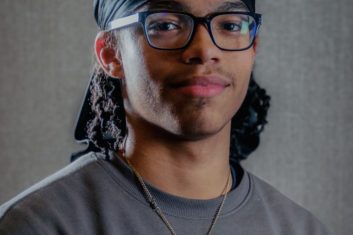It’s the first day of my after-school internship with Community-Word Project. As a Teaching Artist in training, I have been assigned to assist a professional Teaching Artist. I have been warned also that the kids at this residency are particularly tough for a variety of reasons, but I approach the experience with an open mind. Besides, I’ve taught a class of students on my own, so it can’t be that bad. Right?
4:30 p.m. sharp we walk into the classroom with our game faces on. A minute later, twelve or so little nuggets stream in. I’ve got this. No sweat.
My Teaching Artist asks everyone to get in a circle on the rug for a warm-up activity. One or two students join her, but the rest disobey. Two rambunctious boys chase each other around the room. Some try to leave the classroom, while students from other classrooms run into ours. It is chaos.
The TA tries to control the group with several vocal cues, but is unsuccessful. She modifies her request, asking them to jump up and down together to release some energy. When that fails, she modifies her directions again and again and again. None of her tactics align the class.
Relative peace is achieved only when we introduce the main drawing activity. However, the two boys are still running around the room. We compromise, allowing them to play their game as long as they follow a couple of safety guidelines. “I hate after-school,” says one disgruntled seven year-old as he storms away from me. What do you say to that?
It is finally 5:30 p.m. We round up the students and take them to parent pick-up. It has only been an hour, but the Teaching Artist, a fellow intern and myself are all feeling exhausted. I feel like I’ve aged from 21 to 30 in an instant. Maybe they weren’t children after all, but rather miniature age-sucking demons.
After recovering from the terrifying possibility that I had just spent an hour with twelve dementors, I strategized how we could get the class on track. Luckily, I am prepared for this. I am currently a trainee in Community-Word Project’s Teaching Artist Training & Internship Program and during one of our seminars we discussed the ups and downs of teaching in an after-school setting.
Princeton University lecturer Jean B. Grossman acknowledges the caveats of after-school, noting that, “locating these programs in schools brings many strengths; but […] it also brings unique challenges that should be taken into consideration.”
These challenges include:
- Limited classroom space
- Student demographic
- Transportation to the program
Remembering these factors was extremely helpful in putting our woes into perspective. As in most after-school settings, we had limited agency over the classroom space. We were assigned a random teacher’s room and could not disrupt the setup or use the school’s materials. Also, many of the kids had woken up extremely early to commute to school and have had 8+ hours of class prior to after-school. They are tired, hungry and mentally spent. A final complication was flexible dismissal. Parents could pick up their kids at any time during the after-school period so students would randomly leave class. It is difficult to have a cohesive classroom community when the group fluctuates each week.
As I brainstormed, I also called upon a key concept from TATIP’s classroom management seminar—proactive rather than reactive measures. Author and educator Martin Henley explains that, “rather than waiting for problems to develop and then reacting, proactive teachers organize their classrooms to promote positive behavior.” Classroom management is not only about damage control. It includes the preparative measures a teacher takes before class begins to establish the tone and expectations.
Some proactive measures we discussed in our TATIP workshops include having an opening activity, or a “Do Now” as Patti Chilsen, lead trainor calls them. These are activities that are ready to go the moment the students walk in the classroom, such as graffiti walls; stretching and warm-ups with music; call and response activities, etc.
These proactive strategies in mind, our teaching team decided to set the space in a new way the following week—the class became ‘Superhero Island.’ Perhaps we could focus their scattered energy and have fun together by introducing silly characters and creating a world that transformed their usual classroom and school environment.
Our fearless Teaching Artist leader entered the class that day not as herself, but as the ridiculous, knee-high sock wearing superhero, “Captain Crazy Socks”. Her intern sidekicks, ‘The Wanderer’ and myself, ‘Sally Sweet,’ followed closely behind. I chose to adopt a terrible Julie Andrews-esque accent in order to complete my superhero persona. The kids were wildly amused.
The difference from the previous week’s class was astounding. Everyone sat in a circle, something the TA had never seen them complete in their time together. The students took turns sharing their superhero personas and their superpowers. They listened attentively when it was another’s turn to speak. Later, some made comics and booklets of their superhero adventures as well as costume pieces, while others jumped straight into pretend superhero battle scenes. The crowning moment of class was when the same little boy that previously said, “I hate after-school,” asked us, “Can we do this tomorrow?” Funnily enough, this little boy’s superhero name was “Black Heart.”
This time, we left the class invigorated. By creating a specific classroom setting and maintaining it for the entirety of the class, we kept the students unified and engaged. All they needed was a space to be creative and silly after a long school day. A fun activity, a whimsical play space, and a few clear guidelines made that possible. Mission accomplished!
-Ally Tufenkjian, Theatre Artist, TATIP Trainee



